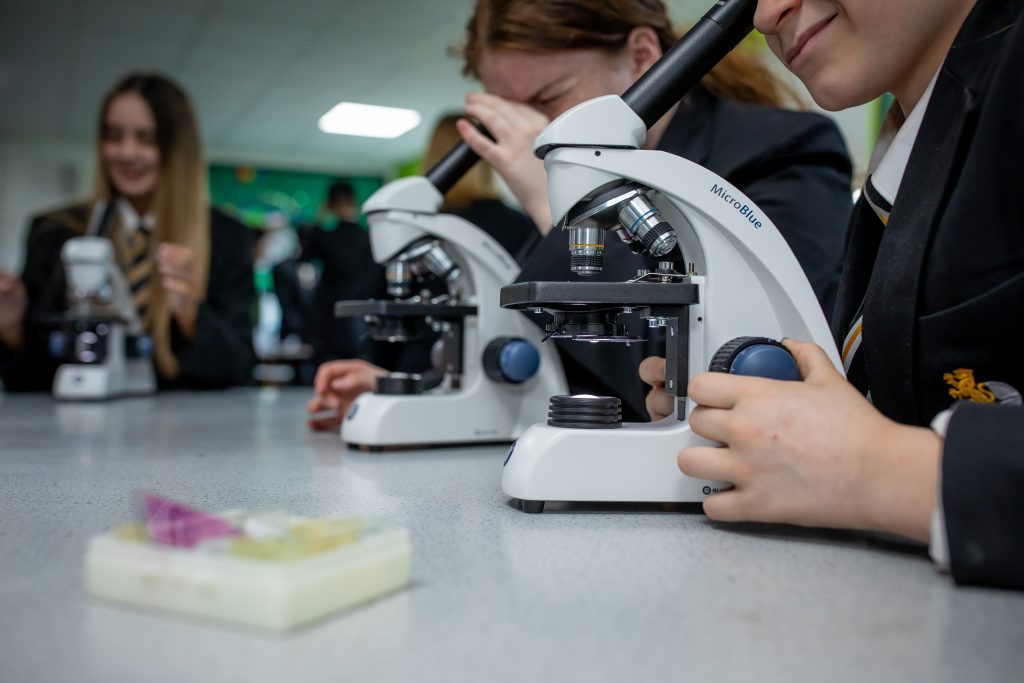Science
Science encompasses everything that we are and allows us to make sense of the world around us. A high-quality science education should develop students’ curiosity and scientific knowledge in order to question the world in which we live, enable critical thinking and encourage students to become socially aware global citizens. As students progress through their scientific education, they should be able apply their scientific thinking and vocabulary to explain a wide range of phenomena, develop their experimental skills through a variety of scientific investigations and use their observations to justify the conclusions they have made, whilst using their analytical and evaluative skills to critically analyse information they are presented with.
The Science curriculum followed by students at Weavers Academy is ambitious, innovative, and serves the needs of all of our students. At the core of this curriculum is its knowledge-rich nature, ensuring that students are provided with the content that they need to succeed within the subject disciplines. Alongside this, subject leaders have also built-in authentic diverse content ensuring that all students feel a sense of belonging as they enjoy their journey through their curriculum.

Click here for learning resources
Key Stage 3:
Year 7
Year 7: By the end of the year students are aware of the purpose of the steps in scientific methodology and can conduct lab work purposefully and safely.
- In biology students have the scientific literacy to discuss ecosystems, cells and movements, digestion and gas exchange.
- In chemistry students have developed an understanding of the foundations of Chemistry, Earth Sciences and the periodic table and elements.
- In physics students can model situations involving forces and light and sound.
- Thinking like a Scientist skills (Analyse, Communicate, Enquire and Solve) run throughout all topics intertwined in the delivery of practical skills, data handling and knowledge. Students will develop their lab skills as well as an appreciation of the benefits of diversity in Science at the beginning of the year.
Year 7 Curriculum Map
|
|
Autumn |
Spring |
Summer |
|
Biology |
Ecosystems |
Cells and Movement |
Digestion and Gas Exchange |
|
Chemistry |
Foundations of Chemistry |
Earth Structure and Rock Cycle |
Periodic table and elements |
|
Physics |
Introduction to Physics |
Sound and Light |
Quantifying Energy |
Year 8
By the end of year 8 students can and can conduct experimental investigations and obtain valid results and use graphical techniques to analyse and interpret results.
- In biology students have the knowledge to accurately discuss genetics and evolution, reproduction in plants and animals and photosynthesis and respiration.
- In chemistry students can use conventions in chemistry to describe rocks, earth science, metals and non-metals and acids and alkalis.
- In physics students can analyse situations involving sound and light, space and electricity and electromagnetism, including the use of numeracy for calculations.
- Thinking like a Scientist skills (Analyse, Communicate, Enquire and Solve) run throughout all topics intertwined in the delivery of practical skills, data handling and knowledge. Students will understand and be critical of how science is portrayed in the media.
Year 8 Curriculum Map
|
|
Autumn |
Spring |
Summer |
|
Biology |
Genetics and Evolution |
Reproduction |
Photosynthesis and Respiration |
|
Chemistry |
Separating Mixtures |
Climate and resources |
Metals and Non-metals, acids and alkalis. |
|
Physics |
Forces and Motion |
Space |
Electricity and Electromagnetism |
Year 9
By the end of year 9 students can develop experimental methods and use accurate apparatus and techniques. They can relate fundamental knowledge to evidence collected in the lab and how that is used to develop models.
- In biology students have acquired the fundamental knowledge about microbiology and the challenges in healthcare. They have the numeracy skills for biology to apply to more complex problem solving.
- In chemistry students can use conventions in chemistry to explain what happens on an atomic level when reactions occur, the different types of reactions that occur and explain the structure and behaviour of atoms, elements, compounds and mixtures.
- In physics students can apply mathematical skills to analyse energy transfers, apply ideas about particle theory to explain changes of state, use models to explain the interaction of waves with matter, and analyse the effects of forces.
- Thinking like a Scientist skills (development of scientific thinking, experimental skills and strategies, analysis and evaluation, scientific vocabulary) run throughout all topics. Students develop Maths in Science skills to prepare them for the challenge of GCSE and beyond.
Year 9 Curriculum Map:
|
|
Autumn Term |
Spring Term |
Summer Term |
|
Biology |
Health |
Cells – Core concepts |
Ecosystems |
|
Chemistry |
Types of reactions. |
Chemical energy |
Fundamentals of Chemistry |
|
Physics |
Energy- heating and cooling |
Wave Interactions |
Forces and their effects |

Key Stage 4:
At Key Stage 4, students follow either the AQA GCSE Combined Science: Trilogy or AQA GCSE Triple Science specification.
AQA GCSE Combined Science: Trilogy
| Biology | Chemistry | Physics |
|---|---|---|
| Subject Content: 1. Cell biology 2. Organisation 3. Infection and response 4. Bioenergetics 5. Homeostasis and response 6. Inheritance, variation and evolution 7. Ecology |
Subject Content: 8. Atomic structure and the periodic table 9. Bonding, structure, and the properties of matter 10. Quantitative chemistry 11. Chemical changes 12. Energy changes 13. The rate and extent of chemical change 14. Organic chemistry 15. Chemical analysis 16. Chemistry of the atmosphere 17. Using resources |
Subject Content: 18. Energy 19. Electricity 20. Particle model of matter 21. Atomic structure 22. Forces 23. Waves 24. Magnetism and electromagnetism |
| How is this assessed? 2 Written exams – 1 hour 15 minutes each Foundation or Higher Tier 70 marks 16.7% of GCSE |
How is this assessed? 2 Written exams – 1 hour 15 minutes each Foundation or Higher Tier 70 marks 16.7% of GCSE |
How is this assessed? 2 Written exams – 1 hour 15 minutes each Foundation or Higher Tier 70 marks 16.7% of GCSE |

AQA Triple Science
| GCSE Biology | GCSE Chemistry | GCSE Physics |
|---|---|---|
| Subject content: 1. Cell biology 2. Organisation 3. Infection and response 4. Bioenergetics 5. Homeostasis and response 6. Inheritance, variation and evolution 7. Ecology 8. Key ideas |
Subject content: 1. Atomic structure and the periodic table 2. Bonding, structure, and the properties of matter 3. Quantitative chemistry 4. Chemical changes 5. Energy changes 6. The rate and extent of chemical change 7. Organic chemistry 8. Chemical analysis 9. Chemistry of the atmosphere 10. Using resources |
Subject content: 1. Energy 2. Electricity 3. Particle model of matter 4. Atomic structure 5. Forces 6. Waves 7. Magnetism and electromagnetism 8. Space physics (physics only) |
| How is AQA GCSE Biology assessed? Paper 1: Topics 1–4: Cell biology; Organisation; Infection and response; and Bioenergetics. Written exam: 1 hour 45 minutes Foundation and Higher Tier 100 marks 50% of GCSE Paper 2: Topics 5–7: Homeostasis and response; Inheritance, variation and evolution; and Ecology. Written exam: 1 hour 45 minutes Foundation and Higher Tier 100 marks 50% of GCSE |
How is AQA GCSE Chemistry assessed? Paper 1: Topics 1–5: Atomic structure and the periodic table; Bonding, structure, and the properties of matter; Quantitative chemistry, Chemical changes; and Energy changes. Written exam: 1 hour 45 minutes Foundation or Higher Tier 100 marks 50% of GCSE Paper 2: Topics 6–10: The rate and extent of chemical change; Organic chemistry; Chemical analysis, Chemistry of the atmosphere; and Using resources. Written exam: 1 hour 45 minutes Foundation and Higher Tier 100 marks 50% of GCSE |
How is AQA GCSE Physics assessed? Paper 1: Topics 1-4: Energy; Electricity; Particle model of matter; and Atomic structure. Written exam: 1 hour 45 minutes Foundation and Higher Tier 100 marks 50% of GCSE Paper 2: Topics 5-8: Forces; Waves; Magnetism and electromagnetism; and Space physics. Written exam: 1 hour 45 minutes Foundation and Higher Tier 100 marks 50% of GCSE |
Curriculum Map:
| Autumn | Spring | Summer | ||
|---|---|---|---|---|
| Year 10 | Biology |
Organisation Bioenergetics Cell Bio Recap |
Infection and Response | Ecology |
| Chemistry |
Atomic Structure Bonding |
Quantitative Chemistry Chemical Change |
Energy Changes The rate and extent of chemical change |
|
| Physics |
Energy Electricity |
Particle Model Atomic Structure |
Forces | |
| Year 11 | Biology |
Homeostasis and response Inheritance, Variations and Evolution |
Revision and QLA | Revision and QLA |
| Chemistry |
Organic Chemistry Chemical Analysis |
Chemistry of the Atmosphere Using Resources |
Revision and QLA | |
| Physics |
Waves Magnetism and Electromagnetism Space (Triple Only) |
Revision and QLA | Revision and QLA | |

Key Stage 5:
Students at Weavers Academy have the opportunity to study up to four level 3 Science subjects/courses, i.e. OCR A-Level Biology A , OCR A-Level Chemistry A, OCR A-Level Physics A and WJEC Level 3 Applied Diploma in Medical Science.
OCR Biology A A-Level
| Subject content: | How is OCR A-Level Biology A assessed? |
|---|---|
| Module 1: Development of practical skills in biology Module 2: Foundations in biology Module 3: Exchange and transport Module 4: Biodiversity, evolution and disease Module 5: Communication, homeostasis and energy Module 6: Genetics, evolution and ecosystems |
Paper 1 – Biological processes 100 marks, 2 hours 15 mins 37% of A-level Assesses content from modules 1, 2, 3 and 5 Paper 2 – Biological diversity 100 marks, 2 hours 15 mins 37% of A-Level Assesses content from modules 1, 2, 4 and 6 Paper 3 Unified biology 70 marks, 1 hour 30 mins 26% of A-Level Assesses content from all modules (1 to 6) Practical endorsement in biology Non-exam assessment |

OCR Chemistry A A-Level
| Subject content: | How is OCR Chemistry A A-Level assessed? |
|---|---|
| Module 1 – Development of practical skills in chemistry Module 2 – Foundations in chemistry Module 3 – Periodic table and energy Module 4 – Core organic chemistry Module 5 – Physical chemistry and transition elements Module 6 – Organic chemistry and analysis |
Paper 1 – Periodic table, elements and physical chemistry 100 marks, 2 hour 15 mins 37% of A-Level Assesses content from modules 1, 2, 3 and 5 Paper 2 – Synthesis and analytical techniques 100 marks, 2 hour 15 mins 37% of A-Level Assesses content from modules 1, 2, 4 and 6 Paper 3 – Unified chemistry 70 marks, 1 hour 30 minute 26% of A-Level Assesses content from all modules (1 to 6) Practical endorsement in chemistry Non-exam assessment |

OCR Physics A A-Level
| Subject content: | How is OCR Physics A A-Level assessed? |
|---|---|
| Module 1: Development of practical skills in physics Module 2: Foundations in physics Module 3: Forces and motion Module 4: Electrons, waves and photons Module 5: Newtonian world and astrophysics Module 6: Particles and medical physics |
Paper 1 – Modelling physics 100 marks, 2 hours 15 mins 37% of A-Level Assesses content from modules 1, 2, 3 and 5 Paper 2 – Exploring physics 100 marks, 2 hours 15 mins 37% of A-Level Assesses content from modules 1, 2, 4 and 6 Paper 3 – Unified physics 70 marks, 1 hour 30 mins 26% of A-Level Assesses content from all modules (1 to 6) Practical endorsement in physics Non-exam assessment |

WJEC Level 3 Applied Diploma in Medical Science
| Subject content: | How is this assessed? |
|---|---|
| Unit 1: Human health and disease Unit 2: Physiological measurement techniques Unit 3: Medical Science research methods Unit 4: Medicines and treatment of disease Unit 5: Clinical laboratory techniques Unit 6: Medical case study |
25%, external 12.5%, internal 12.5%, internal 25%, internal 12.5%, external 12.5%, external |